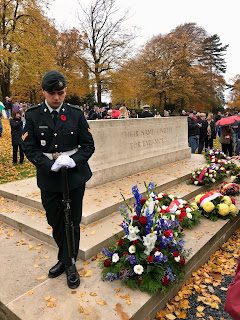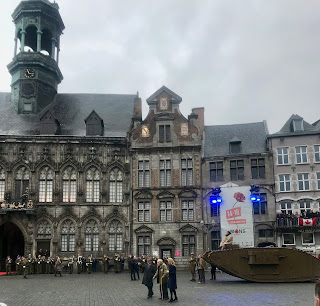 |
| La Grande Place Mons on 10th November prepares for the Armistice Day |
At Casteau, a village on the eastern limits of Mons, there are two low key memorials that bookend WW1.
This one on the left marks the spot where the first shot of the war was fired by Corporal Thomas of the 4th Royal Irish Dragoon Guards started a skirmish that ended with a six mile pursuit to Soignies and the capture of five Germans by Captain CD Hornby and his men. The plaque reads:This tablet is erected to commemorate the action of 'C' squadron 4th Royal Irish Dragoon Guards on 22nd August. Corporal B Thomas fired the first shot for the British Expeditionary Force and Captain CB Hornby led the first mounted attack against the Germans.
Across the road, literally, an even more obscure plaque, today hidden behind a parked digger, denotes the place where the Canadians paused on their way to liberate Mons on the morning of 11th November.
We took in the station on the canal, at Obourg on the outskirts of Mons, where the Middlesex Brigade performed heroics on the afternoon of 23rd August in the battle 'proper' for Mons. They held out for hours against overwhelming numbers before retreat into Mons became a necessity. The plaque reads:
Near this spot on 23rd August 1914 the honour fell to the 4th battalion Middlesex Regiment to fire the first shots of the Battle of Mons. On the roof of this building an unidentified British soldier made the supreme sacrifice in order to protect the retreat of his comrades.
The enormous and impressive Mons Communal Cemetery has large areas devoted to CWG and Belgian War dead from both world wars. The CWG area is designed by Lutyens and is unusual for the number of nationalities marked there. The photo below includes British, Russian, Rumanian, French and German headstones.
Beautiful trees throughout the main area filled with mausoleums and extravagant memorials.
A moving ceremony for the Armistice was held here today. The atmosphere was fitting - a chilly breeze with lowering skies above showers of yellowed beech leaves. The town has been largely made over to the Canadians, who predominated in the liberation of the town on 10th and 11th November.
Finally, a two hour ceremony in the Grande Place:
The Canadian Defence Minister addresses the crowd and participants.
The elderly gent being helped across the square is the 91 years old nephew of George Lawrence Price, the last British and Empire soldier to die in the war, killed by a sniper's bullet at 10.58am on 11th November.










No comments:
Post a Comment